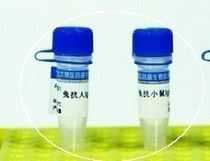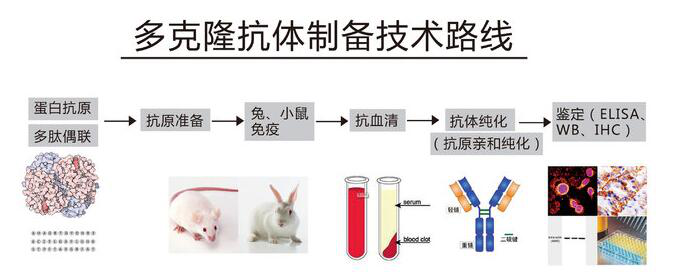
|

| 产地 | 进口、国产 |
| 品牌 | 上海莼试 |
| 保存条件 | Store at -20 °C |
| 货号 | CS10622 |
| 应用范围 | WB=1:100-500 ELISA=1:500-1000 IP=1:20-100 IHC-P=1:100-500 IHC-F=1:100-500 IF=1:100-500 |
| CAS编号 | |
| 抗体名 | Anti-Parkin protein/PARK2 |
| 克隆性 | |
| 靶点 | 详见说明书 |
| 适应物种 | 详见说明书 |
| 形态 | 详见说明书 |
| 宿主 | 详见说明书 |
| 亚型 | IgG |
| 标识物 | 详见说明书 |
| 浓度 | 1mg/1ml% |
| 免疫原 | KLH conjugated synthetic peptide derived from human Parkin protein C-terminus |
中文名称 帕金蛋白抗体规格
英文名称 Anti-Parkin protein/PARK2
别 名 AR JP; E3 ubiquitin protein ligase parkin; FRA6E; LPRS 2; LPRS2; PARK 2; PARK2; Parkinson disease (autosomal recessive juvenile) 2; Parkinson disease protein 2; Parkinson juvenile disease protein 2; PDJ; PRKN 2; PRKN; PRKN2; Ubiquitin E3 ligase PRKN.
产品属性:
帕金蛋白抗体规格 浓 度 1mg/1ml
规 格 0.1ml/100μg 0.2ml/200μg
抗体来源 Rabbit
克隆类型 polyclonal
交叉反应 Human, Mouse, Rat, Pig
产品类型 一抗
研究领域 细胞生物 免疫学 神经生物学
蛋白分子量 predicted molecular weight: 51kDa
性 状 Lyophilized or Liquid
免 疫 原 KLH conjugated synthetic peptide derived from human Parkin protein C-terminus
亚 型 IgG
纯化方法 affinity purified by Protein A
储 存 液 0.01M PBS, pH 7.4 with 10 mg/ml BSA and 0.1% Sodium azide
帕金蛋白抗体规格 产品应用 WB=1:100-500 ELISA=1:500-1000 IP=1:20-100 IHC-P=1:100-500 IHC-F=1:100-500 IF=1:100-500
(石蜡切片需做抗原修复)
not yet tested in other applications.
optimal dilutions/concentrations should be determined by the end user.
保存条件 Store at -20 °C for one year. Avoid repeated freeze/thaw cycles. The lyophilized antibody is stable at room temperature for at least one month and for greater than a year when kept at -20°C. When reconstituted in sterile pH 7.4 0.01M PBS or diluent of antibody the antibody is stable for at least two weeks at 2-4 °C.
Important Note This product as supplied is intended for research use only, not for use in human, therapeutic or diagnostic applications.
产品介绍 Parkinson's Disease, the second most common neurodegenerative disease after Alzheimer's Disease, is characterized by the loss of dopaminergic neurons and the presence of Lewy bodies (comprised of alpha synuclein and parkin inclusions). Autosomal Recessive Juvenile Parkinsonism (AR-JP) is a recently described form of Parkinson's Disease that has been linked to a gene that codes for parkin. Parkin, a 52 kDa protein, has a suggested role in the ubiquitin/proteasome pathway for protein degradation. The amino terminus bears sequence homology to ubiquitin while functionally it acts as a RING type ubiquitin protein ligase (E3) that coordinates the transfer of ubiquitin to substrate proteins, thus targeting them for degradation by the proteasome.
Function : Functions within a multiprotein E3 ubiquitin ligase complex, catalyzing the covalent attachment of ubiquitin moieties onto substrate proteins, such as BCL2, SYT11, CCNE1, GPR37, STUB1, a 22 kDa O-linked glycosylated isoform of SNCAIP, SEPT5, ZNF746 and AIMP2. Mediates monoubiquitination as well as 'Lys-48'-linked and 'Lys-63'-linked polyubiquitination of substrates depending on the context. Participates in the removal and/or detoxification of abnormally folded or damaged protein by mediating 'Lys-63'-linked polyubiquitination of misfolded proteins such as PARK7: 'Lys-63'-linked polyubiquitinated misfolded proteins are then recognized by HDAC6, leading to their recruitment to aggresomes, followed by degradation. Mediates 'Lys-63'-linked polyubiquitination of SNCAIP, possibly playing a role in Lewy-body formation. Mediates monoubiquitination of BCL2, thereby acting as a positive regulator of autophagy. Promotes the autophagic degradation of dysfunctional depolarized mitochondria. Mediates 'Lys-48'-linked polyubiquitination of ZNF746, followed by degradation of ZNF746 by the proteasome; possibly playing a role in role in regulation of neuron death. Limits the production of reactive oxygen species (ROS). Loss of this ubiquitin ligase activity appears to be the mechanism underlying pathogenesis of PARK2. May protect neurons against alpha synuclein toxicity, proteasomal dysfunction, GPR37 accumulation, and kainate-induced excitotoxicity. May play a role in controlling neurotransmitter trafficking at the presynaptic terminal and in calcium-dependent exocytosis. Regulates cyclin-E during neuronal apoptosis. May represent a tumor suppressor gene.
Subunit : Forms an E3 ubiquitin ligase complex with UBE2L3 or UBE2L6. Mediates 'Lys-63'-linked polyubiquitination by associating with UBE2V1. Part of a SCF-like complex, consisting of PARK2, CUL1 and FBXW7. Interacts with SNCAIP. Binds to the C2A and C2B domains of SYT11. Interacts and regulates the turnover of SEPT5. Part of a complex, including STUB1, HSP70 and GPR37. The amount of STUB1 in the complex increases during ER stress. STUB1 promotes the dissociation of HSP70 from PARK2 and GPR37, thus facilitating PARK2-mediated GPR37 ubiquitination. HSP70 transiently associates with unfolded GPR37 and inhibits the E3 activity of PARK2, whereas, STUB1 enhances the E3 activity of PARK2 through promotion of dissociation of HSP70 from PARK2-GPR37 complexes. Interacts with PSMD4 and PACRG. Interacts with LRRK2. Interacts with RANBP2. Interacts with SUMO1 but not SUMO2, which promotes nuclear localization and autoubiquitination. Interacts (via first RING-type domain) with AIMP2 (via N-terminus). Interacts with PSMA7 and RNF41. Interacts with PINK1.
Subcellular Location : Cytoplasm, cytosol. Nucleus. Endoplasmic reticulum. Mitochondrion. Note=Mainly localizes in the cytosol. Co-localizes with SYT11 in neutrites. Co-localizes with SNCAIP in brainstem Lewy bodies. Relocates to dysfunctional mitochondria that have lost the mitochondrial membrane potential; recruitment to mitochondria is PINK1-dependent.
Post-translational modifications : Auto-ubiquitinates in an E2-dependent manner leading to its own degradation. Also polyubiquitinated by RNF41 for proteasomal degradation.
S-nitrosylated. The inhibition of PARK2 ubiquitin E3 ligase activity by S-nitrosylation could contribute to the degenerative process in PD by impairing the ubiquitination of PARK2 substrates.
DISEASE : Defects in PARK2 are a cause of Parkinson disease (PARK) [MIM:168600]. A complex neurodegenerative disorder characterized by bradykinesia, resting tremor, muscular rigidity and postural instability. Additional features are characteristic postural abnormalities, dysautonomia, dystonic cramps, and dementia. The pathology of Parkinson disease involves the loss of dopaminergic neurons in the substantia nigra and the presence of Lewy bodies (intraneuronal accumulations of aggregated proteins), in surviving neurons in various areas of the brain. The disease is progressive and usually manifests after the age of 50 years, although early-onset cases (before 50 years) are known. The majority of the cases are sporadic suggesting a multifactorial etiology based on environmental and genetic factors. However, some patients present with a positive family history for the disease. Familial forms of the disease usually begin at earlier ages and are associated with atypical clinical features.
Similarity : Belongs to the RBR family. Parkin subfamily.
Contains 1 IBR-type zinc finger.
Contains 2 RING-type zinc fingers.
Contains 1 ubiquitin-like domain.
Database links : UniProtKB/Swiss-Prot: O60260.2
parkin基因的突变,患者很早就会出现氏症的,Parkin属于RBR蛋白家族,与泛素相关蛋白分解途径有关。
实验流程:

全、新、优、品、好四大特点:
帕金蛋白抗体规格 全:公司提供上万种产品,涵盖了生物试剂,elisa试剂盒,标准品,培养基,原装耗材,抗体、培养基、ATCC细胞等,基本上各种科研所需产品在我司都能找到。
新:产品更新速度较快,基本上每周都有新产品出现。
优:产品质量好,投诉比较少。
好:我公司具有优质的技术团队,产品一旦售出,实验过程中遇到困难可提供在线技术咨询。使您使用产品时没有任何的后顾之忧。
技术外包服务:
★帕金蛋白抗体规格 分子生物学:质粒抽提、PCR、Q-PCR、RT-PCR、分子生物学:基因合成、引物合成、基因测序、载体构建等
★蛋白工程:原核、哺乳动物蛋白表达系统等
★病毒包装:腺病毒、慢病毒等
★抗体工程:磁珠分选、病理染色、WB、ELISA、IP、IF、IHC、FACS、Confocal等等
★细胞工程:细胞表型分析(凋亡、增殖、周期、迁移、侵袭、修复、克隆形成)、细胞培养、细胞膜制备、稳定细胞株构建、细胞RNAi技术等等。
正在热销的相关产品:
Anti-p-ERK1/p-MAPK-1/2 /FITC 荧光素标记磷酸化原活化蛋白激酶1/2抗体IgGMulti-class antibodies规格: 0.2ml
Anti-MTL/FITC 荧光素标记胃动素抗体IgGMulti-class antibodies规格: 0.2ml
Rhesus antibody Rh C1orf172 1号染色体开放阅读框172抗体 规格 0.2ml
TGF- Beta1 (Ttansforming Growth Factor – Beta1) 转移生长因子–β1(抗原) 0.5mg
HSP70 英文名称: 热休克蛋白70抗体 0.1ml
Rhesus antibody Rh RRAGA RAS相关GTP结合蛋白A抗体 规格 0.2ml
Anti-MTL/FITC 荧光素标记胃动素抗体IgGMulti-class antibodies规格: 0.2ml
Anti-Lpin1 protein/FITC 荧光素标记Lpin1 抗体IgGMulti-class antibodies规格: 0.2ml
Anti-phospho-Synapsin I (Ser9) /FITC 荧光素标记磷酸化神经突触素1抗体IgGMulti-class antibodies规格: 0.2ml
Rhesus antibody Rh Adiponectin Receptor 1 脂联素受体1抗体 规格 0.2ml
Rabbit Anti-Goat IgG/Alexa Fluor 555 Alexa Fluor 555标记的兔抗羊IgG 0.1ml
GPR48 英文名称: G蛋白偶联受体48抗体 0.1ml
Rhesus antibody Rh Rabbit Anti-chicken IgM/FITC FITC标记的兔抗鸡IgM 规格 0.3ml
Anti-phospho-Synapsin I (Ser9) /FITC 荧光素标记磷酸化神经突触素1抗体IgGMulti-class antibodies规格: 0.2ml
EAR3(Human eosinophil-associated ribonuclease A family member 3)ELISA Kit 人嗜酸性相关之RNA水解酵素家族成员3Multi-class antibodies规格: 48T
Anti-MUC5AC/Mucin 5AC 胃粘液素抗体Multi-class antibodies规格: 0.1ml
Rhesus antibody Rh Insulin 抗体 规格 0.1ml
ACA-IgM(Human anti-cardiolipin antibody IgM) ELISA Kit 人抗心磷脂抗体IgM 96T
Phospho-PDGFRA(Tyr1018) 英文名称: 磷酸化血小板源性生长因子受体-α抗体 0.1ml
C1D 英文名称: 核DNA结合蛋白C1D抗体 0.1ml
Anti-MUC5AC/Mucin 5AC 胃粘液素抗体Multi-class antibodies规格: 0.1ml
CL-0282HO-8910PM(人高转移细胞)5×106cells/瓶×2
TNFSF11 Others Mouse 小鼠 RANKL / OPGL / TNFSF11 / CD254 人细胞裂解液 (阳性对照)
小鼠颌下腺上皮细胞完全培养基 100mL
L W-3A小鼠皮下结缔组织细胞 L W-3A mice subcutaneous connective tissue cells DMEM培养基+10%FBS
IL1A Protein Mouse 重组小鼠 IL-1 alpha / IL1A / IL1F1 蛋白
P3X63Ag8.653(小鼠细胞) 5×106cells/瓶×2 L6(大鼠成肌细胞)
CL-0278HCCLM3(人高转移细胞)5×106cells/瓶×2
IL17RB Others Mouse 小鼠 IL17BR / IL17RB / IL-17 Receptor B 人细胞裂解液 (阳性对照)
人晶状体上皮细胞cDNAHLEpiC cDNA
LCC1细胞,人癌细胞 VERO衍生株,SVP细胞 成骨细胞Many types of cells包装:5 × 105次方(1ml)
TG-905(人脑胶质母细胞瘤细胞) 5×106cells/瓶×2
HPMEC Pellet 人肺微内皮细胞团块 > 1 mio.cells 多聚赖氨酸 1 mg/mlPLL
帕金蛋白抗体规格 CD200 Others Cynomolgus 食蟹猴 CD200 人细胞裂解液 (阳性对照)
平滑肌细胞Many types of cells包装:5 × 105次方(1ml)
615小鼠滑膜瘤株;ZM755
LTEP-s细胞,人肺鳞癌细胞 小鼠皮肤细胞,JB6-C30细胞 CL-0114Hs 578T(人癌细胞)5×106cells/瓶×2
Tca-8113(人舌鳞癌细胞) 5×106cells/瓶×2
HBdMEC-c 人膀胱微内皮细胞(HBdMEC) 500,000cells 皮下脂肪细胞Many types of cells包装:5 × 105次方(1ml)